Secret Garden

Beez Neez now Chy Whella
Big Bear and Pepe Millard
Wed 30 Sep 2015 22:57
|
Our Visit to the Secret
Garden
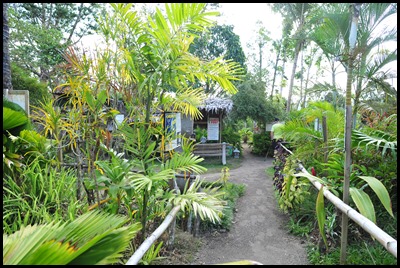  After our busy
morning sussing out ‘stuff’ in Port Vila town, we headed out of town to visit
The Summit – a botanical garden, sadly, we passed a sign that told us the garden
closed at three and we needed a few hours to do the place justice. Too late this
afternoon, we turned-tail and went to the Secret Garden that we had passed along
the way. We were met by Steve who would be our guide. When he had shown us
around we were free to bimble on our own until closing at half past five. We
started in the plant area showing traditional crops
grown for food and those used for shelter.
  Next stop was to do some ‘petting’,
first a coconut crab who was not too bothered about
us feeling his ‘squadgy’ bits, between the leathery shield parts are really soft
bits. This chap is about three years old so not too massive.
   The varied diet
schedule made us smile, Steve said if the chaps here were destined for
the table they would be fed for at least two weeks just on coconut for the
unique coconutty taste. The chap we held had small
claws compared to some giants like this one about to
rob a dustbin for scraps.
 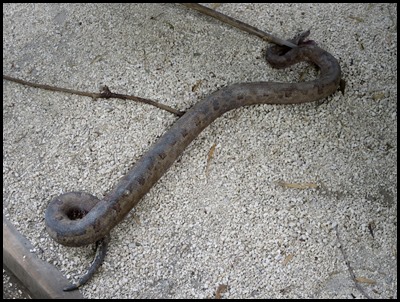 Vanuatu only has two types of snake,
a small, dark, burrowing snake and the Pacific Boa.
The genus candoia is truly a very different one indeed. These boas, in general,
all look quite similar. They all have narrow, triangular, flat heads with an
upturned rostral [beaky bit]. Their heads make them look venomous, and in some
way prehistoric. All Pacific boas have thick keeled scales and strong prehensile
tails. As with all boas, these snakes are nocturnal. Adult sizes range from
twenty two inches to nine feet in length, the average being three to five feet.
Candoia are only found in the South Pacific and occupy a range of habitat
including dry woodlands to rain forests. They eat rats and mice and enjoy
bathing in water. On some islands they are involved with customary magic.
Many Ni-Vanuatu are frightened of these snakes
despite the fact that they will only give a nasty nip, I
don’t blame them at all. The big snakes have to handled very
carefully, I could see Bear swallowing hard as he watched Steve catch this wild lady – she will only be kept for a couple
of months, then she will be set free and another will be caught to show the
likes of us.
   Of course he
did, let it be stated - only for the blog
readers. I thought this lady was incredibly compact, very heavy for her size, very raspy big scales and of course
cold to the touch. I thought she flexed and tightened
the second she got around my neck, noooooo. I was fascinated to
watch her tail, it gently felt around my arm and then
my glasses.
  Big Bear it could be worse, I could
have asked you to do a snake dance as they do in the Banks Islands. OOWwwwwwww you’ve got to be kidding, I’m happy to pose with
this tamtam and I’ll hold it very firmly as my manly appendage is trying to
hide. The tamtam is a hollowed-out log,
carefully carved and when hit with sticks makes a huge drum noise, used for
sending messages within a village or to nearby villages. Big tamtams struck hard
can be heard for miles.
   Oh mentioning manly bits takes me
nicely into the namba or the penis sheath – worn by
men in South Pentecost, Malekula, Ambryn and parts of the Banks Islands. They
vary in size, shape and design. They are normally made
from finely woven pandanus or banana leaves and are sometimes coloured with red
dye. Sometimes it is looped over a belt that can be thick or thin. The famous
Big Nambas tribe in the north and the Small Nambas in the central part of the
southern area of Malekula, are named after the size of their respective penis
sheaths. I’m strictly staying silent over which group Bear would be qualified to
join........ Grrrrr, don’t you growl at me.
Steve titters and you can stop your tittering
too........anyhoooo... Traditionally men always cover their manhood
except in the Banks Islands where they used to be naked. Nambas don’t usually
cover the scrotum.
Felix Peiser advised in 1920, that
when men stripped naked they would use their finger to cover the eye of the
penis for fear of magic, to which the penis is susceptible. “The site of that of
another man being considered most dangerous.” Again, I will stay extremely
quiet.......... The third picture above is a photograph taken by Jean Guiart from the Musee de l’homme in Paris
shows two men from Futuna in 1890. Futuna males had
the largest nambas in Vanuatu – bigger than Big nambas, similar to those worn in
Tanna. Oh we’re going there, I must get Bear in a National Geographic-type
picture in a group of locals methinks. Steve piped up “do you want to have a
sneak look at what Bear will look like”, that would be great. Excuse me you two. Oh hush, just go and
pose..........
   Fantastic, Bear
looks great. Wait until I snap the real thing, can I wait, yes, I can wait.............. I pose too. I think yours is a
little more flattering than mine.........somehow. Role on getting
Beez well and organising this in Tanna, in hindsight I saw this picture of a
variation with the namba covered with a bit of grass
skirt, perhaps this is a better look.......Huh......Just a suggestion. Huh and thrice Huh..
 On to a bit of head modification. The
‘Long Headed People of Tomman Island’ in Malekula thought it was an attractive
thing to lengthen their heads to make themselves fashionable and thus more
beautiful – in their eyes. People grew up with their heads almost half as long
again and sloped off to a rounded point. Babies had strange baskets put on their
heads from the age of three days. First a cloth woven from human hair was fitted
over the head. This was then soaked in coconut oil to soften the skull. Then
after a few days the basket is put on and the soft skull is moulded into the
elongated shape desired. The basket was woven from coconut fibre in such a way
that the strands could be tightened day after day until the bones were too hard
to be further compressed. When the child reached one year the basket was taken
off as the head was sufficiently deformed. The practice died out prior to the
war. This photograph of a Tomman woman with her baby wearing
the basket was taken around 1920.
  A traditional
house and the interior of one built on stilts.
 Only Bear could get a pair of banded iguanas to pose like
this..........
 The banded iguana has featured on
stamps.
    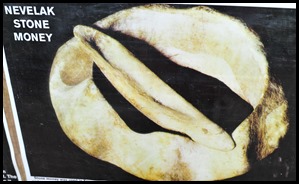   Traditional
Money. Before the Reserve Bank of Vanuatu introduced modern currency,
traditional custom money was used to barter or pay for things. Pigs, tusks,
shells, fossilised stones, feathers and mats have been used as traditional money
in the past.
In Vanuatu, the pig had and still has
a high value. The pig is the standard value of money that all other traditional
money is related to. In central and northern Vanuatu only tusked pigs were
considered valuable. The value of the pig depended on the development and
curvature of the tusks. If the tusks grew back into their own roots or emerged
again on the inner side of the jaws, the value of the pig diminished because the
tusks were prevented from growing properly but if the tusk had a normal
curvature so they completed a circle a second or third time, the pig acquired a
very great value.
Shell strings were worn as ornaments
and were quite rare to be used as money in some islands such as Malekula but in
the Banks Islands shell strings were commonly used for money to buy rank in the
social structure of the community and to buy wives.
Stone money was used Erromango in the
form of fossilised clam shells called navilah. They were quartzite and had the
form of a ring or other shape of a crescent moon and came in all sizes, the
value of which was related to the shape and size. They were used as amulets and
were a common payment.
Feather money was used in the
eighteenth century in Malo and the Banks Islands. It consisted of a string of
bird feathers from parrots of different colours. Feather money was gradually
replaced by shell money. Feathers were used to decorate bodies and as body
adornment became more ritualised the value of certain types of feathers
increased.
Mat money was and still is used as
traditional money in Malekula, Pentecost, Ambae and Maevo. In these islands mats
were only used as money. They were used to buy rank in the social structure of
the community and to purchase wives. The red colour mats are the most valuable.
Mats were produced in large quantities and are still used today.
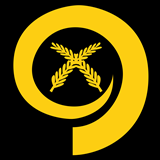 The pigs tusk is
on the flag of Vanuatu
Credit System. In the New Hebrides
there was a traditional type of credit system used and still is used in rural
areas. The system involves borrowing a pig or pigs from a wealthier member of
the community. The loan [pig] was usually borrowed for a certain period of time
at a certain rate of interest, this interest rate was an agreement between the
lender and the borrower but was not fixed. It was not unusual for the interst
rate to be twice what had been borrowed, certainly the case in the Banks
Islands.
Repayment of loans involving pigs was
and is a complicated matter because the pigs have to be returned with a certain
quality where the tusks had developed to the point that would have been reached
plus interest had the pig not been borrowed – bigger tusks. As a result lengthy
disputes often resulted...........
If pigs are to be given as payment it
might include pigs with full circle tusks. Today political parties form
alliances by exchanging or killing a pig. When Jimmy Stevens was released from
prison he had to pay the Vanuatu government thirty pigs in compensation after
serving fourteen years in jail..... The going rate for a wife is ten pigs. One
each for her brain, eyes and nose, lips, shoulders and arms, feet and legs for
dancing, stomach, heart, breasts, private parts and hands. .
  Steve bobbed down, dusted the floor smooth, drew a simple grid and with one
single continuous line, swirled and curled producing the most gorgeous turtle. Sand drawing is something taught from an early age
and in times past was an important way to learn the stories of the
ancestors.
  We shook this chaps hand and he was
happy to pose with Bear. He is deaf and dumb but
works here at the Secret Garden, he dresses traditionally and welcomes tourists
during the day and at the feasts put on in the evening, part of this wonderful
extended family of happy people. Vanuatu has been voted as one of the happiest
places on earth to live. Then Steve introduced us to his pet – a nawemba or Pacific imperial pigeon, considered a delicacy
to eat amongst the Ni-Vanuatu......at least it’s not a
person I suppose [the last recorded case of cannibalism, not the
criminal sort but the traditional kind was in 1969.........]. This chap is
bending down on Steve’s request for “make a noise”, a strange woooooo followed
but a tapping duh-duh-duh-duh. Just chatting before we set off after our bimble
to take pictures we happened to see a colossal spiders web, all fluffy and
white. I said how I used to love spiders until I got my bite in New Zealand.
“Stay right there” and off Steve went.
   Steve was back in a flash and put this
spider in Bear’s paw. It played
possum for a time, slowly unfurled and then scooted for the shelter of fur.
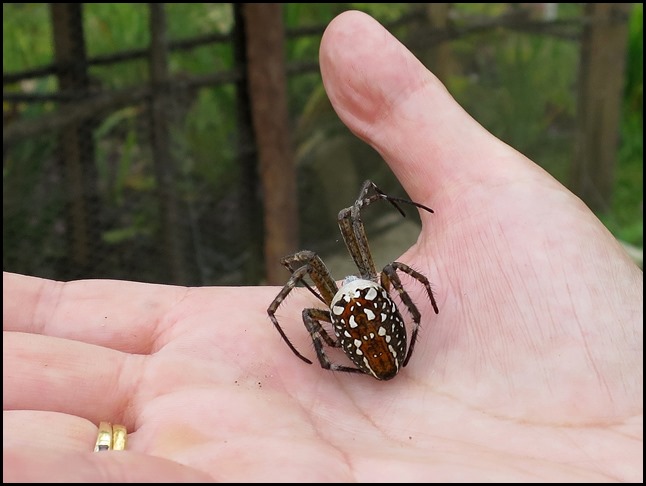 On me he just relaxed and settled, maybe my faith is restored – a bit.
Sadly, it was time to go.
ALL IN ALL A REALLY
INTERESTING PLACE
SURPRISING FIND WITH SO MUCH
INFORMATION |